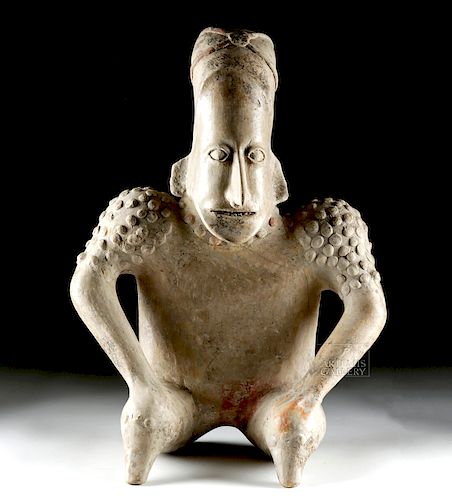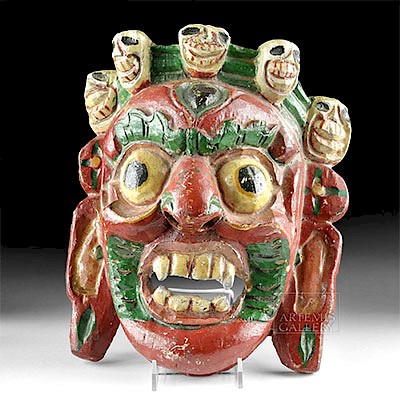Huge Jalisco Ameca Pottery Anthropomorphic Figure
Lot 90
About Seller
Artemis Gallery
686 S Taylor Ave, Ste 106
Louisville, CO 80027
United States
Selling antiquities, ancient and ethnographic art online since 1993, Artemis Gallery specializes in Classical Antiquities (Egyptian, Greek, Roman, Near Eastern), Asian, Pre-Columbian, African / Tribal / Oceanographic art. Our extensive inventory includes pottery, stone, metal, wood, glass and textil...Read more
Estimate:
$2,800 - $4,200
Absentee vs Live bid
Two ways to bid:
- Leave a max absentee bid and the platform will bid on your behalf up to your maximum bid during the live auction.
- Bid live during the auction and your bids will be submitted real-time to the auctioneer.
Bid Increments
| Price | Bid Increment |
|---|---|
| $0 | $25 |
| $300 | $50 |
| $1,000 | $100 |
| $2,000 | $250 |
| $5,000 | $500 |
| $10,000 | $1,000 |
| $20,000 | $2,500 |
| $50,000 | $5,000 |
| $100,000 | $10,000 |
| $200,000 | $20,000 |
About Auction
By Artemis Gallery
Apr 25, 2019
Set Reminder
2019-04-25 10:00:00
2019-04-25 10:00:00
America/New_York
Bidsquare
Bidsquare : Pre-Columbian | Tribal | Ethnographic
https://www.bidsquare.com/auctions/artemis-gallery/pre-columbian-tribal-ethnographic-4035
Featuring ancient and ethnographic art from around the world, including Pre-Columbian, Native American, African / Tribal, Ethnographic, Spanish Colonial, Fossils, Fine Art, much more. Artemis Gallery info@artemisgallery.com
Featuring ancient and ethnographic art from around the world, including Pre-Columbian, Native American, African / Tribal, Ethnographic, Spanish Colonial, Fossils, Fine Art, much more. Artemis Gallery info@artemisgallery.com
- Lot Description
Pre-Columbian, West Mexico, Jalisco, Ameca Grey style, ca. 300 BCE to 300 CE. An incredible seated anthropomorphic figure, hollow-built from pottery, with a highly-burnished surface covered in characteristic Ameca-style grey slip. The figure rests on thick thighs and nubbin feet with an erect posture defined by the planar chest and back. Each muscular shoulder is covered in dozens of small pellet-form appliques indicative of scarification marks, and the stocky arms curve downward with hands fused with the thighs. The haunting visage is composed of heavy-lidded almond eyes, a prominent and slightly-crooked nose, a toothy mouth, cupped ears, and a pointed chin, and a simple headdress with red and cream-hued cords caps the elongated head. A tremendous example of ancient shaft-tomb artistry! Size: 13.625" W x 18.7" H (34.6 cm x 47.5 cm).
West Mexican shaft tomb figures like this example derive their names from the central architectural feature that we know of from this culture. Jalisco, located on Mexico's southwestern coast, was part of the shaft tomb culture during this time, along with neighbors in nearby Colima and Nayarit. These people would build generally rectangular vertical or near-vertical shafts down from the ground level - usually about 3 to 20 meters deep - through tepetate, the volcanic tuff that makes up the geology of the region, to narrow horizontal tunnels that led to one or more vaulted or rounded burial chambers.
These shafts were almost always dug beneath a dwelling, probably a family home, and seem to have been used as family mausoleums, housing the remains of many related individuals. Figures like this one were placed into the tombs; researchers believe that they were placed around the edges facing inward, as if in conversation with the dead. Grouped with other figures, and alongside clay bowls, and boxes, figures like this one were positioned around the body (or bodies), near the skull.
Unfortunately, we lack the necessary information to fully understand what these figures were made for - Did they represent everyday people, even individuals? Were they religious? Were they created to mediate between the living and the dead? Whatever their purpose, today they are beautiful artwork and reminders of the mysterious past.
For a stylistically-similar example from the waist up, please see The British Museum, museum number Am,Hn. 121: https://www.britishmuseum.org/research/collection_online/collection_object_details.aspx?objectId=664490&partId=1
Another stylistically-similar and slightly-smaller example hammered for $6,000 at Sotheby's, New York "African, Oceanic and Pre-Columbian Art" auction (May 14, 2004, lot 148): http://www.sothebys.com/en/auctions/ecatalogue/2004/african-oceanic-and-pre-columbian-art-n07996/lot.148.html
Provenance: ex-private Santa Fe, New Mexico, USA collection
All items legal to buy/sell under U.S. Statute covering cultural patrimony Code 2600, CHAPTER 14, and are guaranteed to be as described or your money back.
A Certificate of Authenticity will accompany all winning bids.
We ship worldwide and handle all shipping in-house for your convenience.
#142911Repaired from multiple large pieces with small chips, overpainting, and light adhesive residue along break lines. Light resurfacing to areas of one hand and back of head. Minor nicks and abrasions to legs, body, arms, and head, with fading to original pigmentation in some areas, and light encrustations in some recessed areas. Nice earthen deposits and manganese deposits throughout.Condition
- Shipping Info
-
All shipping is handled in-house for your convenience. Your invoice from Artemis Gallery will include shipping calculation instructions. If in doubt, please inquire BEFORE bidding for estimated shipping costs for individual items.
-
- Buyer's Premium



 EUR
EUR CAD
CAD AUD
AUD GBP
GBP MXN
MXN HKD
HKD CNY
CNY MYR
MYR SEK
SEK SGD
SGD CHF
CHF THB
THB
















